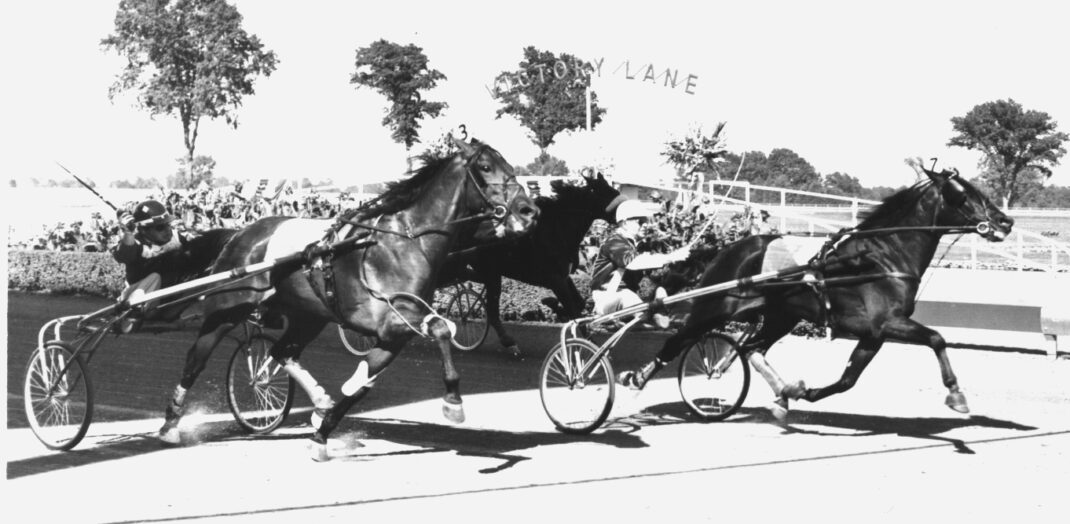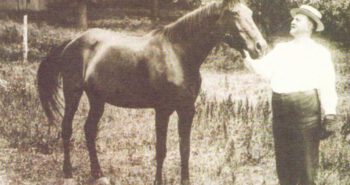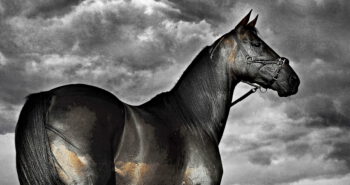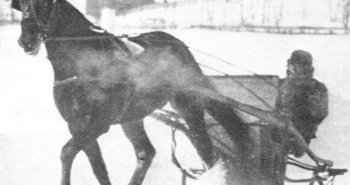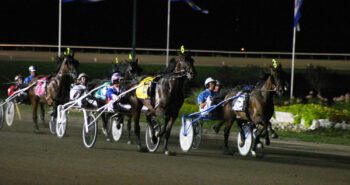The third horse to win the trotting’s Triple Crown, Ayres, was always an great talent, but at 2 there were question marks surrounding the future of his immense ability. Could, and would, it be harnessed properly – or would he go into history as another could-have-been? Despite setting a rather extreme world record at two, Ayres had a mind of his own and had serious issues with authority. A trainer who laid down the law turned the unruly kid around an into a real superstar and Triple Crown-winner.
At two, Ayres was good but a bit inconsistent. The two-year old crop of 1963 was dominated by Speedy Count, but Ayres managed to beat him on occasion and certainly showed massive potential. The highlight was the first heat of the Ohio Standardbred Futurity in September, where Ayres finished 13 lengths ahead of the field and demolished the old world record for two-year-old trotters on a half-mile track. The old record stood at 2:03 1/2 (1.16,8) but Ayres lowered it to a fantastic 2:00.1 (1.14,7). While the crowd gave Ayres a standing ovation, driver John F Simpson Sr felt was upset with the horse. Speaking to the journalist Roy McHugh, Simpson noted that “Ayres set that record on his own. I was trying to take him back. I wanted him to conserve some of that energy for the second and third heats, but no. He went right to the front and took the bit in his mouth. He was like a runaway horse.”
At the start of the second heat, Simpson braced his feet, hugged the reins to his chest and pulled, determined to show the horse who really was the boss – not that the son of Star’s Pride cared much. In fact, Ayres sped the first half-mile even faster than he had in the heat before. But after such an exhaustive effort the trotter broke stride and the heat was won by Smart Rodney and Billy Haughton. This necessitated a race-off where Ayres’ manners simply went completely AWOL. After the first turn, Ayres simply had had enough. The colt flat out quit and turned into the stable area on his own despite Simpson’s tugging and whipping.
A simple plan
The performance earned Ayres a reputation for being a juvenile delinquent. Blazingly fast, but with an attitude problem. Simpson knew, however, that Ayres had enormous potential and his primary task for the winter training was finding the best way to teach the horse sufficient manners. To teach the independent-minded colt, Simpson surrounded him with other horses and gradually begun to get control over the anxious youngster. “I trained him with one horse in front of him and one on the outside and one right behind. I made him train in a box and he had to stay in that box whether he wanted to or not. Del Miller told me.”
Despite Ayres having set a very impressive world record, going into the 1964 season Speedy Count was generally seen as the clear Hambletonian favorite on the back of 21 wins in 27 starts in 1963. In the balloting for horse-of-the-year honors, Speedy Count received 129 votes while Smart Rodney outpolled Ayres 23-13.
A different horse
When he returned from winter training Ayres had learnt his lesson, though, and it was a reformed juvenile delinquent that stepped onto the track. In his first race as a three year old, in the one-mile open trot at The Meadows, Ayres won comfortably in 2:03.1 (1.16,6). He was controllable and did not attempt to run away. After the race, Simpson had a good feeling.
Ayres lost to the older Marco Hanover in a 2:01.1 (1.15,3) race at Sportsman’s Park in Chicago on Jul 4, but after that there was no stopping the three-year-old. In the Yonkers Trot, Ayres lowered the race record from 2:03 to 2:01.3 (from 1.16,4 to 1.15,6) and had no problems dealing with Speedy Count.
When the Hambletonian came around Ayres was a massive favorite and he did not disappoint. In fact, he won in extremely convincing fashion – but not without its special moments. First off there was the start. Ayres got in a few extra hippity hops and broke stride. As it turns out, his imagination was to blame. Television crews had strung a cable across the starting line in order to feed power to cameras at the judging stand. The strand cast a shadow and it spooked the horse. It hadn’t been there the prior day and Ayres remembered. Each time Ayres got to the line, he jumped. When Simpson got Ayres trotting again he sat fifth in the nine horse field. When the duo attacked with a quarter to go, Ayres shifted into overdrive and passed the pack, winning comfortably by a length in record time 1:56.4 (1.12,6). In the second heat Ayres stayed trotting but relinquished the lead to Speedy Count at the quarter. Attacking at the three-quarter pole, Ayres had no problem handling Speedy Count before holding off Big John down the stretch to win by a neck.
Wrapping up the Triple Crown
The only hiccup of the season came in the Dexter Cup at Roosevelt when Dartmouth defeated him by a nose and won in a world record time. Ayres had went off-stride for just a few steps right in front of the wire and that mistake had cost him the race.
Ayres then completed the Triple Crown by winning the Kentucky Futurity in two straight heats. Simpson used the same tactics in both heats, staying off the pace and then charging to the front in the turn for home. In the first heat he just trotted away from the rest to a two lengths win in 1:58.1 (1.13,4). He was pushed hard by Dartmouth in the second heat but prevailed in a photo-finish, winning in 1:59.2 (1.14,2). Simpson and Sheppard had some concerns prior to the Kentucky win, though, as Simpson charged that “someone turned Ayres loose in the stable area Thursday night” and that the colt had suffered a scraped and bruised ankle. Lawrence Sheppard even offered a $5,000 reward for the arrest and conviction of the person who tampered with the horse or its stall, but nothing more came of it. Regardless of what happened, in the race Ayres seemed none the worse. Retiring at the end of 1964, Ayres had won 20 of his 30 lifetime starts and earned $254,027. Naturally, he was voted three-year-old Trotter of the Year.
Ayres was named by his breeder Charlotte Sheppard. Her husband’s (Lawrence Sheppard) mother had earlier built a beautiful home in Accomac, Virginia and named it Ayres Lea (or Lee). Ayres was one of the many horses bred on the Star’s Pride x Hoot Mon golden cross. He was 3×4 linebred on Mr Mcelwyn. His dam Arpege was a full sister to Cassin Hanover, winner of both the Hambletonian and Kentucky Futurity in 1957 and, maybe just as importantly, the dam of Elma and the fourth dam of French superstar Coktail Jet.
The Italian connection
Ayres stood stud at Hanover Shoe Farms and produced the Hambletonian winning full brothers Christopher T and Timothy T. Several of his best get would have a connection to Italy. Timothy T was exported to Italy and won races all over Europe. Italian-bred Top Hanover, out of Elaine Rodney, completely dominated Italian trotting in the early 70s. A few years later, US export The Last Hurray became Italy’s top aged trotter – also that a son of Ayres. Another one who did really well in Italy at the end of the 70s was Granit, out of the legendary Roquepine.
Ayres was the damsire of the excellent Italian trotter Esotico Prad, one of the starters in the 1988 March of Dimes Trot, Choctaw Brave, champion stallion in Finland, and Peter Haughton Memorial winners Why Not and Charlie Ten Hitch.
Ayres died at Hanover Shoe Farms on January 30, 1990, at age 29, and was buried at the farm.
Ayres
Bay colt born at Hanover, PA in 1961. Died at Hanover, PA on Jan 30, 1990.
Star’s Pride – Arpege (Hoot Mon)
30 starts: 20-4-2 – 3,1:56.4 (1.12,6) – $254,027
Breeder: Charlotte Sheppard
Owners: Charlotte Sheppard – Hanover Shoe Farms
Trainer: John F Simpson Sr
Driver: John F Simpson Sr
Groom: Charlie Coleman

